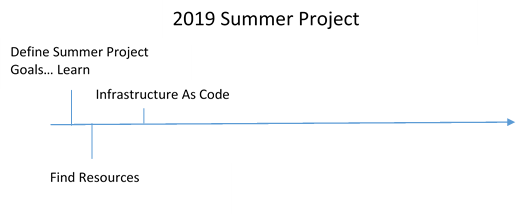In the last post I said I was going to be kicking off my summer project and this year it was going to be around being more aware of cloud computing, by no means am I going to be knowing everything in the 3 weeks I have set aside but I want to be in a better place than I was at the beginning of summer and understand enough to have a good solid conversation with our customers but also the IT Community.

First Steps
I also mentioned in the first post about some of the resources I was going to get into but this will take from those resources my own spin and take on what I learnt and hopefully somewhere out there it helps someone else, I will of course list my resources again at the end.
Initial Overview and Perspective
Having already played in this area a little for just over a year I think I have a pretty good understanding of what Infrastructure As Code is and what benefit it brings, but I also want to make sure I portray my thoughts here as well.
Infrastructure as code is the practice of defining your architecture formally in some form of code usually this looks like a set of templates that describe your architecture along with configuration files for setting parameters. The biggest reasons to use infrastructure as code are to save yourself repeated work and to know exactly what’s in the environment at any point in time. Your infrastructure will become more reliable repeatable and ephemeral by using infrastructure as code you can stand up environments so fast to play around in them and tear them back down to save costs.
When you use infrastructure as code it’s important to stick to using infrastructure as code once you describe something in the template all updates to it need to be made in that template otherwise you risk introducing drift of configuration.
Wikipedia the keeper of truth has a pretty good opener on what IAC is also.
“Infrastructure as code (IaC) is the process of managing and provisioning computer data centers through machine-readable definition files, rather than physical hardware configuration or interactive configuration tools.[1] The IT infrastructure managed by this comprises both physical equipment such as bare-metal servers as well as virtual machines and associated configuration resources. The definitions may be in a version control system. It can use either scripts or declarative definitions, rather than manual processes, but the term is more often used to promote declarative approaches.
IaC approaches are promoted for cloud computing, which is sometimes marketed as infrastructure as a service (IaaS). IaC supports IaaS but should not be confused with it.”
The three reasons I can see people moving this way towards Infrastructure As Code is basically down to Speed, Risk and it offering a highly efficient way of deploying infrastructure.
Speed – If you take a process and you can just copy and paste it then its effectively quicker than typing the line of code or performing the process over and over again IAC allows for that template methodology and how people can take advantage of templating their infrastructure or even applications.
Risk – If you leverage the template like function you are removing the amount of hands on interaction an actual human being needs to have with the infrastructure thus removing risk or at least some risk.
Efficiency – templating analogy again means I can repeat this process over and over again, hundreds and thousands of times and each time we are going to get the same output with the correct parameters and settings.
In the next posts, I am going to drill into some of the key areas that I have found to be most useful to understand and learn more on and I think as a follow up I will go into each one in more detail. In the next post up though I am going to look at the WHY IAC is a thing and how things were and why the needs to make this shift for both on premises and cloud computing.
There are a large number of offerings here and some that I didn’t touch on were the likes of vSphere vRealize Automation, Ansible, Puppet or CHEF all absolutely valid tools to provide IAC but I wanted to keep things broad and also show the Public Cloud native service offerings.
